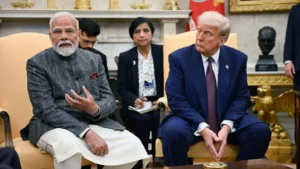India Holds Firm on Russian Oil as US Tariff Threats Loom
Key Developments
- The Trump administration is preparing to impose punitive tariffs of up to 50% on Indian exports in response to New Delhi’s ongoing purchases of Russian crude oil.
- A planned US trade delegation to India was canceled, signaling a hardening of Washington’s stance.
- India continues to import roughly 1 million barrels/day of Russian oil, down from its peak earlier this year, while exploring alternative suppliers.
- Indian officials have strengthened their long-standing ties with Moscow, emphasizing both commercial and strategic rationales.
- India’s trade with the US is valued at $130 billion annually, far higher than the $68 billion trade with Russia—yet Russia remains its largest defense and energy partner.
Why It Matters Geopolitically
India is effectively challenging Washington’s attempt to limit Russian revenues while balancing its need for affordable energy and military supply chains.
Moscow has been a consistent partner since the Cold War, and despite the US being India’s largest trading partner, New Delhi is reluctant to abruptly shift its energy dependence.
Analysts note that a tariff standoff could mark a new phase in the India-US relationship, which has oscillated between cooperation and confrontation.
Strategic trust with Russia remains a safety net for India, contrasting with what many in New Delhi see as “cyclical” ties with the US.
Energy Market Impact
A reduction in Russian crude imports by India would force refiners to look at higher-cost suppliers, potentially increasing India’s import bill by
$3–5 billion per year. This could ripple into global energy prices, especially in Asia’s refined products markets.
US, Middle Eastern, and West African suppliers are already being considered as alternative sources.
For now, refiners remain cautious but have not made a definitive pivot away from Russia. Market watchers expect shipment data for August to clarify whether a trend of rerouting is beginning.
Implications for Day Traders
1) Energy Volatility
- Watch crude benchmarks like WTI and Brent—tariff headlines can trigger sharp price swings intraday.
- Indian refiners (e.g., Reliance, ONGC) and global oil majors may see sympathy moves tied to shipping data and tariff announcements.
2) Trade & Tariff Plays
- Indian ADRs listed in the US (Infosys, Wipro, HDFC Bank) may face tariff-linked selling pressure if the levies take effect.
- Conversely, US exporters with exposure to India could see near-term weakness if retaliation is signaled.
3) Tactical Setups
- Mark the opening range on tariff-deadline days—watch for gap-and-go vs. gap-fill behavior in energy names and India ADRs.
- Track headline risk closely: diplomatic visits, cancellations, or statements from Modi/Trump can all swing tape dynamics.
- ETFs to monitor: EPI (WisdomTree India), XLE (Energy), IEMG (Emerging Markets).
4) Risk Management
- Expect above-average ATR in crude and India ADRs during tariff windows.
- Scale down size near tariff announcement hours; avoid chasing halts or headline bursts.
What’s Next
- Confirmation of the timing and scope of US tariff implementation.
- Potential Indian countermeasures range from WTO appeals to targeted retaliation.
- Putin’s planned visit to India later this year could reinforce energy and defense ties with Moscow.

